You are using an out of date browser. It may not display this or other websites correctly.
You should upgrade or use an alternative browser.
You should upgrade or use an alternative browser.
Akoustyx R-110
- Added by Cinder
- Create date
SHOOTINGTECHIE
100+ Head-Fier
Pros: Head stage is excellent
Imaging and separation are excellent
Great vocals
Great transparency
Well extended treble
Excellent value for 100$
Cable has a mic which is decent
Imaging and separation are excellent
Great vocals
Great transparency
Well extended treble
Excellent value for 100$
Cable has a mic which is decent
Cons: Bass needs more punch\
Leaner notes
Treble needs a little more energy/ sparkle to make it feel like an orchestra in OST
Little more dynamics in notes needed.
No timbre and air
Leaner notes
Treble needs a little more energy/ sparkle to make it feel like an orchestra in OST
Little more dynamics in notes needed.
No timbre and air
ACOUSTYX R-110 and R-220
ACOUSTYX are a Californian Iem company with much presence in the in the recording world. I will be honest, I never heard of them before at all, I just came to know them this year when my friend asked me whether I wanna review some iems like ETYMOTIC and I was like, why not!!! So here we are with ACOUSTYX R-110...
DISCLAIMER- THIS IS A REVIEW UNIT SENT BY ACOUSTYX AS A PART OF REVIEW TOUR IN INDIA, IN EXCHANGE FOR MY HONEST OPINIONS. ALL POSITIVE AND NEGATIVE OPINIONS ARE MINE ENTIRELY AND NOT INFLUENCED AT ALL BY ANYONE NOT EVEN BY MY PARENTS LOL (P.S THEY LOVED THE R220)!!!
UNBOXING-
A simple cardboard box with everything about the iems written on the sides. Then on the inside is a big blue box with a wonderful blue Acoustyx logo which looks epic. Inside we see the iems in the a foam pocket and underneath this is a thick, soft cloth wallet type thing and inside this are all the accessories and they are quite a good amount of them.


BUILD AND FIT-
They are sturdily built out of plastic with having mmcx as a connector and also a black rubber case called as outer ear gel, to cover the inside part of the iem which goes onto the ears and this makes it much more comfortable to use. The fit is decent and goes nicely deep into the ears. No problem with fit whatsoever. One more thing is they have ear hooks which makes it much easier to use it and customize the fit pretty much to very fine adjustments.
The outer iem gel cover has R and L written on it, mindfully though so people don’t try to force it on wrong side iem.

CABLE-
The cable is 4N monocrystalline OCC cable and it comes with a mic. The cable is really decent with no cable noise at all coming through. The mic is decent catches a lot of air but the buttons are clicky and works with both android and IOS (tested on Android and iphone 10 Max). The cable sounds really good too while being slick hehe!!!
The cable has no colour indicators for R and L but you can look for them on the MMCX connectors where there’s a written indicator for it. They need to work on that art.

ACCESSORIES-

SPECIFICATIONS-
BASS AND SUB-BASS
The sub bass is decent for its price and given it’s a BA, it’s fast, accurate and textured. It is not rumbly that will shake you up but it’s just enough to give you a feel of it. There’s not a big body to it either feels. It doesn’t go too deep and doesn’t leave an atmospheric feel to it. Given it’s a reference tuning, its pretty good at what it does!!! Don’t just for depth though which is just not there…
Bass is a different story though!!! It feels tonally, a little lean but feels less energetic like it doesn’t hit hard. There is good midbass body but lacks in the timbre. The decay is so fast that the ending of notes is like near to instant. The bass isn’t also that well extended. Now given a reference set, I didn’t expect it to hit hard or have great timbre but the difference in percussion instruments and the notes of different hits are really very well maintained. Not a hint of the notes from same instrument getting mixed nor the notes of different percussion instruments get mixed. The separation from mids and the transparency of the notes is really good. And that might be required given the need for this iem.

MIDS
The mids are really the star of the show. Theres a lot of transparency and separation continuing the tradition from the bass. The lower mids are slightly more on the leaner side with the notes having more of lean note but much more defined beginnings. The decay is also near instant with not much lingering around of the notes. It has a slight metallic timbre but not too much to make it a problem since it has fast decay. Now unto the string instruments mostly in the upper mids woahhh… These are the best part with lots of details more than I thought it would give. There is good energy and the slight leaner notes makes it feel a bit natural as if listening to them in real life. There is a lot of energy here too to make it a really good experience. The cons I could feel is that the timbre is slight metallic and very fast with lacking in air and slightly less dynamism in some songs. But dynamics can be a little dependent on recordings too but I felt it a bit lacking than what I am used to. Notes clarity even though present might
Vocals on the other hand I feel is pretty balanced. Vocals have great shape to the voice with having good body with lots of extension. It is slightly leaner tonally than what I like but hey my choices are for me haha!!! Don’t get me wrong, the thicker male vocalists do come as thick but the vocals seem to have less width that’s what I meant. They have great reverb and air too. Its pretty great plus its slightly mid forwards I feel like and brings the emotions with it. The energy and dynamics of the vocals are pretty great too. Ohh!! I forgot I didn’t feel any sibilance. The small whispers in the background do come up too.

TREBLE
Its pretty good lean tonally. There is good energy with slightly leaner natural tonality here makes it a good experience. The dynamics are also really great. The lower treble has a good energy and spicy feel making rock music, an energetic experience. The transparency is excellent here too with great deal of separation among the notes. The hi-hats though felt a little lacking in energy but cymbals had a nice hit to them. Trumpets had a great deal of energy and felt real just lacking in air. The notes have great extension and resolution too, it just shows you everything. Timbre might be slightly metallic but it’s not too much to cause an issue. Upper treble has great energy overall with great extension too. It’s not too bright either. There is good of amount of reverb which comes up too.
HEADSTAGE
Now this is excellent in this. This is a wide iem with lots of stage depth that is missed in many others. This has good depth too. Only thing is it’s not too tall but guys enough for my tastes and also this fills the sonic headroom as well when needed by the recording. I guess, now I know why all the reference sets I tried have so beautiful staging, it’s required that’s why
 .
.
IMAGING, RESOLUTION AND SEPARATION
Imaging is great but the exact location on the head stage is a little missed. But the location is in between diffuse and perfect. The resolution is extremely good for this price, every small note in the head stage comes up excellently. The separation is uhm, may I say the best part of this iem. It's just an excellent item and the faster decay obviously helps here.
COMPARISONS
PROS R110
Great micro-details
Wide and tall headstage
Great transperancy
Good mids
Better sub-bass
Better treble performance
PROS ER2XR (off my memory)
Better bass
Tonality is more organic or thicker.
Notes are better defined
Smoother treble performance
Better timbre
PROS DN3
Better bass and sub-bass
Thicker tonality but sibilant vocals
Better acoustic instruments presentation
Better price

SUMMARY
R-110 is made as a reference iem and for the price of 150$ it excels in it a lot. Had there been a little more timbre and better bass texture, this would have triumphed over everything else.
ACOUSTYX are a Californian Iem company with much presence in the in the recording world. I will be honest, I never heard of them before at all, I just came to know them this year when my friend asked me whether I wanna review some iems like ETYMOTIC and I was like, why not!!! So here we are with ACOUSTYX R-110...
DISCLAIMER- THIS IS A REVIEW UNIT SENT BY ACOUSTYX AS A PART OF REVIEW TOUR IN INDIA, IN EXCHANGE FOR MY HONEST OPINIONS. ALL POSITIVE AND NEGATIVE OPINIONS ARE MINE ENTIRELY AND NOT INFLUENCED AT ALL BY ANYONE NOT EVEN BY MY PARENTS LOL (P.S THEY LOVED THE R220)!!!
UNBOXING-
A simple cardboard box with everything about the iems written on the sides. Then on the inside is a big blue box with a wonderful blue Acoustyx logo which looks epic. Inside we see the iems in the a foam pocket and underneath this is a thick, soft cloth wallet type thing and inside this are all the accessories and they are quite a good amount of them.


BUILD AND FIT-
They are sturdily built out of plastic with having mmcx as a connector and also a black rubber case called as outer ear gel, to cover the inside part of the iem which goes onto the ears and this makes it much more comfortable to use. The fit is decent and goes nicely deep into the ears. No problem with fit whatsoever. One more thing is they have ear hooks which makes it much easier to use it and customize the fit pretty much to very fine adjustments.
The outer iem gel cover has R and L written on it, mindfully though so people don’t try to force it on wrong side iem.

CABLE-
The cable is 4N monocrystalline OCC cable and it comes with a mic. The cable is really decent with no cable noise at all coming through. The mic is decent catches a lot of air but the buttons are clicky and works with both android and IOS (tested on Android and iphone 10 Max). The cable sounds really good too while being slick hehe!!!
The cable has no colour indicators for R and L but you can look for them on the MMCX connectors where there’s a written indicator for it. They need to work on that art.

ACCESSORIES-
- A neoprene padded pouch with 2 different compartments.
- 3 pairs of silicone gels of sizes S, M & L.
- 1 pair of double flap tips.
- 1 outer gel cover.
- 1 pair of M comply T-100.
- 3 pairs of ear hooks- aka Freebit ear interface of sizes S, M & L.

SPECIFICATIONS-
- DRIVER- 1 Knowles BA.
- IMPEDANCE- 50 ohm.
- SENSITIVITY- 108 dB.
- PORTABLE -N6II WITH T01 MODULE, BTR5 AND LG G8X
- DESKTOP- DAC- N6II WITH T01 LINEOUT
- AMP- TOPPING A30 MODDED WITH BURSON V5I D OR TOPPING L30 OR XDUOO MT602(NOT USED HERE FOR REVIEW BUT HEY IT DOES HELP TO ADD A BIT OF TUBE TOUCH)
- Would like to add that my DAP N6ii ran it on high gain at 40-50 on volume.
- The tips used are BGVP W01 tips (the included wide bore vocals tips)
BASS AND SUB-BASS
The sub bass is decent for its price and given it’s a BA, it’s fast, accurate and textured. It is not rumbly that will shake you up but it’s just enough to give you a feel of it. There’s not a big body to it either feels. It doesn’t go too deep and doesn’t leave an atmospheric feel to it. Given it’s a reference tuning, its pretty good at what it does!!! Don’t just for depth though which is just not there…
Bass is a different story though!!! It feels tonally, a little lean but feels less energetic like it doesn’t hit hard. There is good midbass body but lacks in the timbre. The decay is so fast that the ending of notes is like near to instant. The bass isn’t also that well extended. Now given a reference set, I didn’t expect it to hit hard or have great timbre but the difference in percussion instruments and the notes of different hits are really very well maintained. Not a hint of the notes from same instrument getting mixed nor the notes of different percussion instruments get mixed. The separation from mids and the transparency of the notes is really good. And that might be required given the need for this iem.

MIDS
The mids are really the star of the show. Theres a lot of transparency and separation continuing the tradition from the bass. The lower mids are slightly more on the leaner side with the notes having more of lean note but much more defined beginnings. The decay is also near instant with not much lingering around of the notes. It has a slight metallic timbre but not too much to make it a problem since it has fast decay. Now unto the string instruments mostly in the upper mids woahhh… These are the best part with lots of details more than I thought it would give. There is good energy and the slight leaner notes makes it feel a bit natural as if listening to them in real life. There is a lot of energy here too to make it a really good experience. The cons I could feel is that the timbre is slight metallic and very fast with lacking in air and slightly less dynamism in some songs. But dynamics can be a little dependent on recordings too but I felt it a bit lacking than what I am used to. Notes clarity even though present might
Vocals on the other hand I feel is pretty balanced. Vocals have great shape to the voice with having good body with lots of extension. It is slightly leaner tonally than what I like but hey my choices are for me haha!!! Don’t get me wrong, the thicker male vocalists do come as thick but the vocals seem to have less width that’s what I meant. They have great reverb and air too. Its pretty great plus its slightly mid forwards I feel like and brings the emotions with it. The energy and dynamics of the vocals are pretty great too. Ohh!! I forgot I didn’t feel any sibilance. The small whispers in the background do come up too.

TREBLE
Its pretty good lean tonally. There is good energy with slightly leaner natural tonality here makes it a good experience. The dynamics are also really great. The lower treble has a good energy and spicy feel making rock music, an energetic experience. The transparency is excellent here too with great deal of separation among the notes. The hi-hats though felt a little lacking in energy but cymbals had a nice hit to them. Trumpets had a great deal of energy and felt real just lacking in air. The notes have great extension and resolution too, it just shows you everything. Timbre might be slightly metallic but it’s not too much to cause an issue. Upper treble has great energy overall with great extension too. It’s not too bright either. There is good of amount of reverb which comes up too.
HEADSTAGE
Now this is excellent in this. This is a wide iem with lots of stage depth that is missed in many others. This has good depth too. Only thing is it’s not too tall but guys enough for my tastes and also this fills the sonic headroom as well when needed by the recording. I guess, now I know why all the reference sets I tried have so beautiful staging, it’s required that’s why
IMAGING, RESOLUTION AND SEPARATION
Imaging is great but the exact location on the head stage is a little missed. But the location is in between diffuse and perfect. The resolution is extremely good for this price, every small note in the head stage comes up excellently. The separation is uhm, may I say the best part of this iem. It's just an excellent item and the faster decay obviously helps here.
COMPARISONS
PROS R110
Great micro-details
Wide and tall headstage
Great transperancy
Good mids
Better sub-bass
Better treble performance
PROS ER2XR (off my memory)
Better bass
Tonality is more organic or thicker.
Notes are better defined
Smoother treble performance
Better timbre
PROS DN3
Better bass and sub-bass
Thicker tonality but sibilant vocals
Better acoustic instruments presentation
Better price

SUMMARY
R-110 is made as a reference iem and for the price of 150$ it excels in it a lot. Had there been a little more timbre and better bass texture, this would have triumphed over everything else.
Cinder
Formerly known as Res-Reviews
Pros: Excellent detail capture, bass and treble extension, great accessory package, top-notch comfort, isolation, and ergonomics, MMCX detachable cables, great carrying case, neutral tonality, stage-monitor-like presentation
Cons: Case lacks crush protection

You can find the R-110 available on the Akoustyx official website for $99 (on sale!), here.
About My Preferences: Heads up, I’m a person! As such, these words are my opinion, and they are tinged by my personal preferences. While I try to mitigate this as much as possible during my review process, I’d be lying if I said my biases are completely erased. So for you, my readers, keep this in mind:
- My ideal sound signature would be an extended sub-bass with a leveled, but textured, mid-bass.
- I have a mild treble sensitivity.
HTC U11 -> USB-C adapter -> earphones
or
Hidizs AP100 3.5mm out -> FiiO A5 3.5mm out -> earphones
or
HiFiMAN SuperMini -> earphones
or
PC optical out -> HiFiMe SPDIF 9018 Sabre DAC 3.5mm out -> earphones
All music was served as MP3 @320Kbps or as FLAC.
Tech Specs
- Driver: Micro Reference Balanced Armature
- Impedance: 50 Ω @ 1KHz
- Sensitivity: 108dB
- Frequency Response: 15–22.000Hz
- Cable Length: 1.2M (4.0 ft)
- Microphone: 4mm Omni Directional
Sonic Overview:
The R-110 is a mildly V-shaped IEM with a brighter midrange, extended treble, and tight bass. It has a quick and precise attack and decay — perfect for eeking out as much detail and texture from a track as possible.
Sonic Breakdown:
Treble: Songs used: In One Ear, Midnight City, Outlands, Satisfy, Little One, Show Me How To Live (Live at the Quart Festival)
I’ve tested many, many IEMs at this point, no small part of which have laid claim to their own special “proprietary” driver technology. This is, mostly, just marketing jargon designed to whip up attention and excitement — that is to say, the end product usually isn’t that special. So when I heard that Akoustyx had their own proprietary tech inside their drivers, I was initially unimpressed. However, after spending as much time as I have with the R-110, its become clear that whatever treatment the BA drivers inside it have gotten, the drivers now have more than an off-the-shelf sound signature. The treble is one of the more obvious examples of this. A single BA in the R-110 brings forwards enough upper-register details to put some other multi-BA IEMs to shame. During In One Ear, a song which has quite a bit of treble-bound activity in the background, I was able to distinguish and focus in on the individual cymbals and high-hats that are oh-so-prevalent. Further, I could easily and clearly make out the singer’s breathing as well as the talking and murmuring in the intro of the song, two key benchmarking points for treble quality for me.
The R-110 is free from sibilance. Across all the songs I tested, it never got too harsh and never lost control of itself during poorly-mastered songs.
Midrange: Songs used: Flagpole Sitta, Jacked Up, I Am The Highway, Dreams, Too Close, Little Black Submarines
The R-110’s midrange is, acoustically, pretty neutral and un-colored. I found myself enjoying it quite a bit on everything from electric guitars in Rock, to synths in electronic music, to acoustic guitars in Indy. The R-110’s versatile nature makes it a joy to use across a genre-diverse music collection. As far as detail goes, the story is much the same as with the treble: there’s tons of it. While I can’t quite call it a giant-killer, I am tempted.
When it comes to vocals, the R-110 has no particular preference for male or female vocals. While my preferences dictate that male vocals need more heft to them, listeners who lean towards balance and neutrality will likely be satisfied with the way the R-110 presents itself by default.
Bass: Songs used: Moth, Gold Dust, In For The Kill (Skream Remix), War Pigs (Celldweller Remix)
The R-110 is not designed to be a bass-heavy IEM. That said, it is not completely vacant of bass in ways such as the Earnine EN-100 or the Simgot EN700. I could easily and clearly make out the bass guitars of Moth, and they felt bodied and well-extended. For purposes such as this, the R-110’s bass is certainly sufficient. For electronic music, it's more of a mixed bag. Depending on the mastering style of the individual track you are listening to, you can end up with a bass that is just right or one that is lacking a little something. For example, I found Gold Dust to sound fine, as its drops had body, impact, and a fair amount of rumble. But for War Pigs I often found myself wishing for a meatier mid-bass.
Packaging / Unboxing


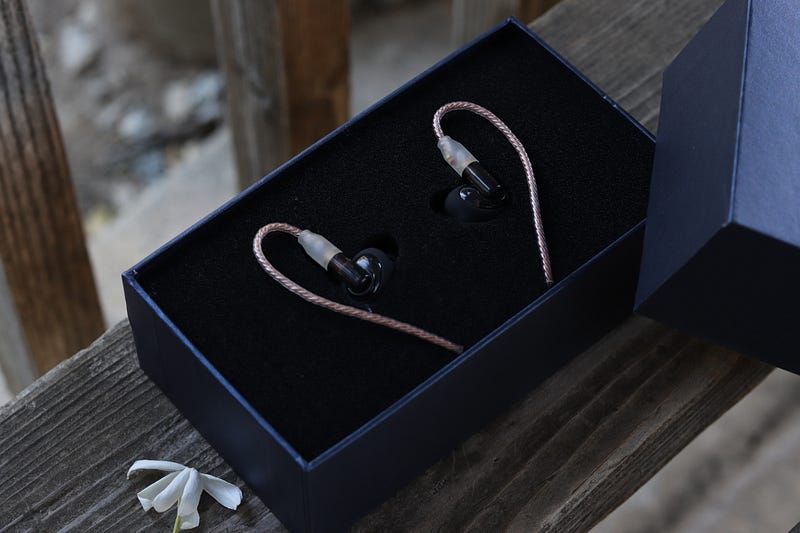
Build
Construction Quality
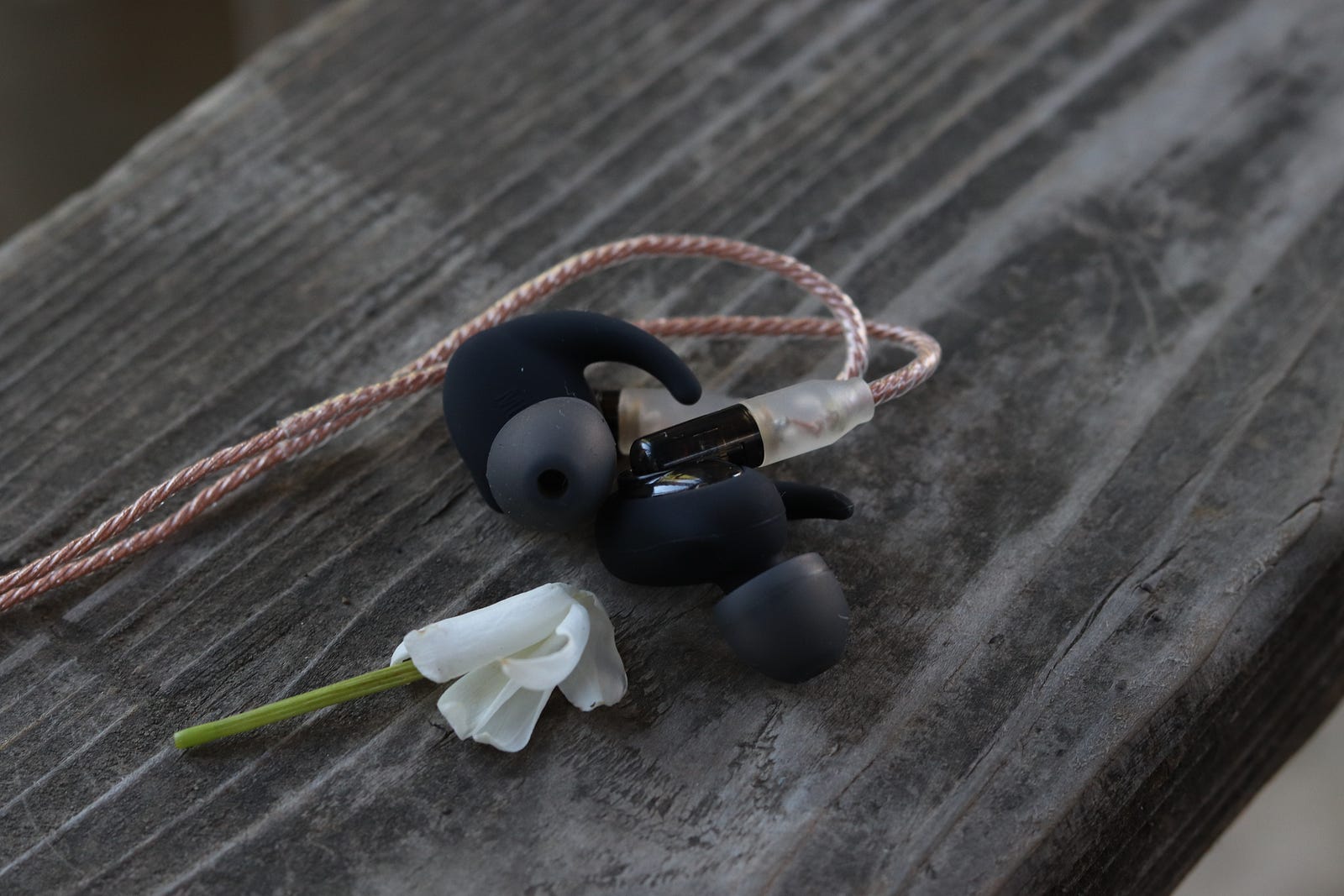

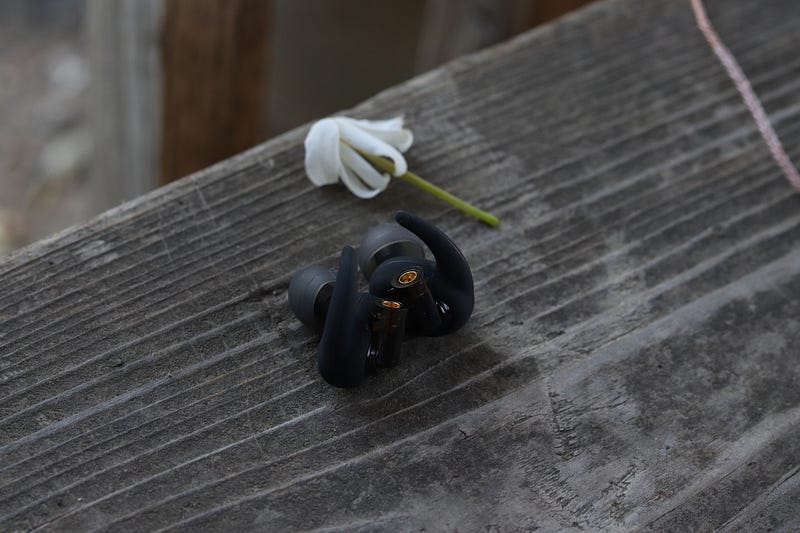
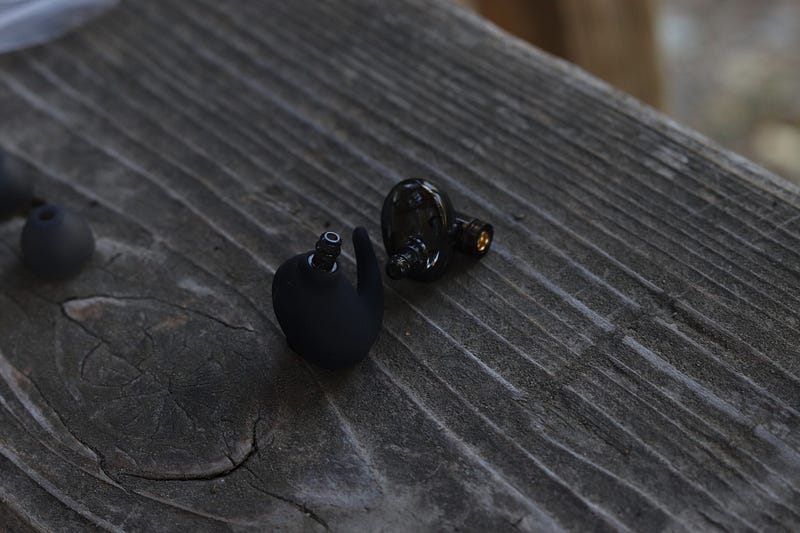
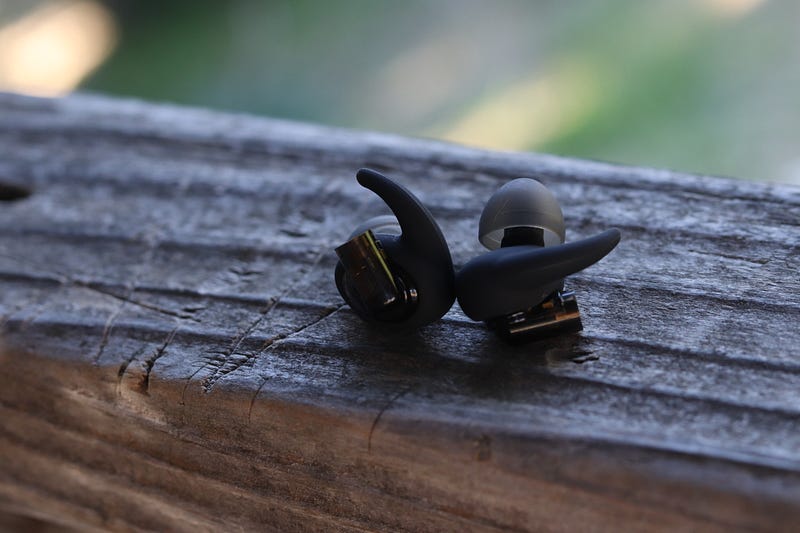
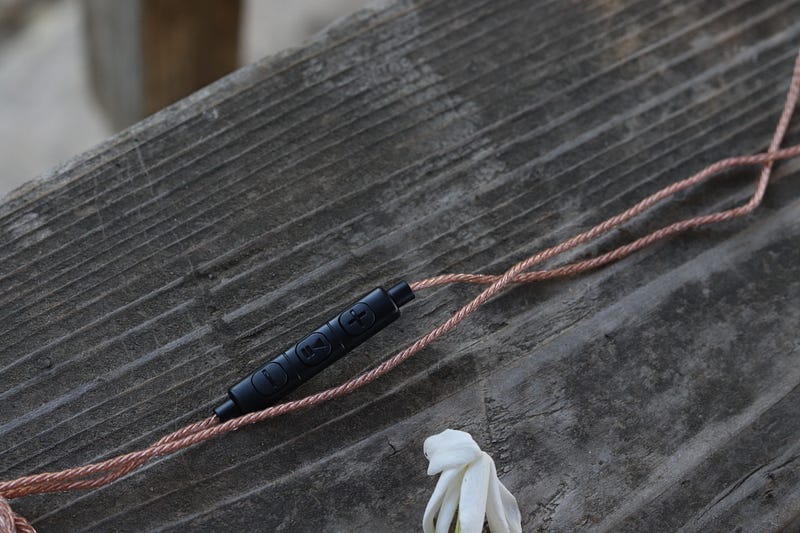

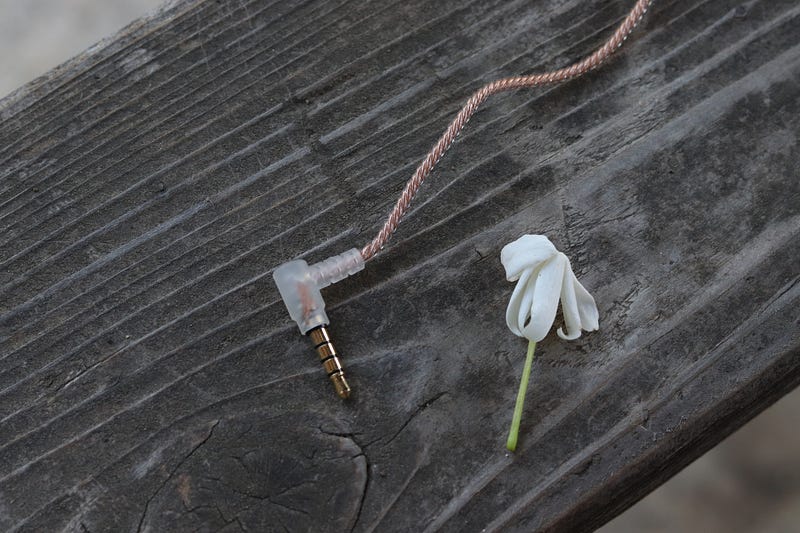
The R-110’s cable is a thing of beauty. It is, as I previously mentioned, made out of four twisted cores. Underneath the clear plastic sheathing lies the high-purity copper that conducts the music to your ears. The cable’s MMCX connectors, Y-splitter, chin slider, and 3.5mm jack, are each housed in a frosted white plastic. You can see some of the wirings underneath each surface. This blend of utilitarianism and traditional aesthetics is refreshingly novel, at least in a form where it is being done correctly. Being given visual access to the wiring of the R-110’s cable, it's clear to see that it is done well, and with care. I have no longevity concerns for the R-110’s cable, and even if I did, it would matter little — after all, the R-110 features detachable cables. An aftermarket one wouldn’t be too hard to find.
Comfort
As the R-110 is chasing the status of “stage-monitor”, being ergonomic is a key factor. Some might say ergonomics are the most key factor. Akoustyx is well aware of this and, in large part, designed the R-110 around the principals of comfort. The R-110 is incredibly comfortable to use, even for very extended periods of time. I was able to get a comfortable seal with excellent isolation with ease. The R-110’s lightweight build and small nozzle size make it an excellent choice for those with smaller or irritable ears too.
To test the fabled ear-retention mechanism (ear hooks) that Akoustyx touts so much, I took the R-110 in a variety of high-stress active situations. I have spent a cumulative four hours rock climbing/bouldering with the R-110, five hours bike-riding, and three hours running. In each of these activities, I’ve had no issues with the R-110 becoming loose, bar one or two times while landing from a seven-foot drop while bouldering, and rarely, if ever, felt discomfort. I’d say that the R-110, and by extension the rest of the R1-series from Akoustyx, has some of the most competent ear-retention of any IEM I’ve tested.
Accessories
Inside the box, you’ll find:
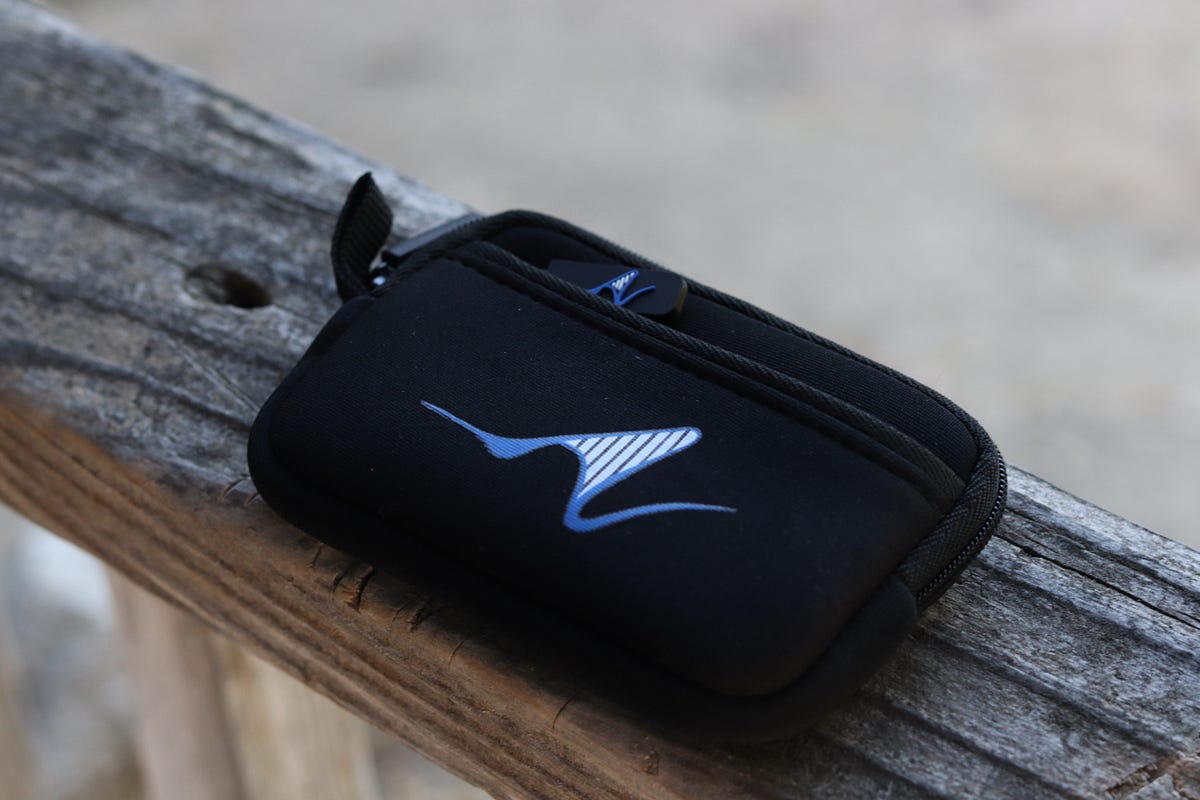
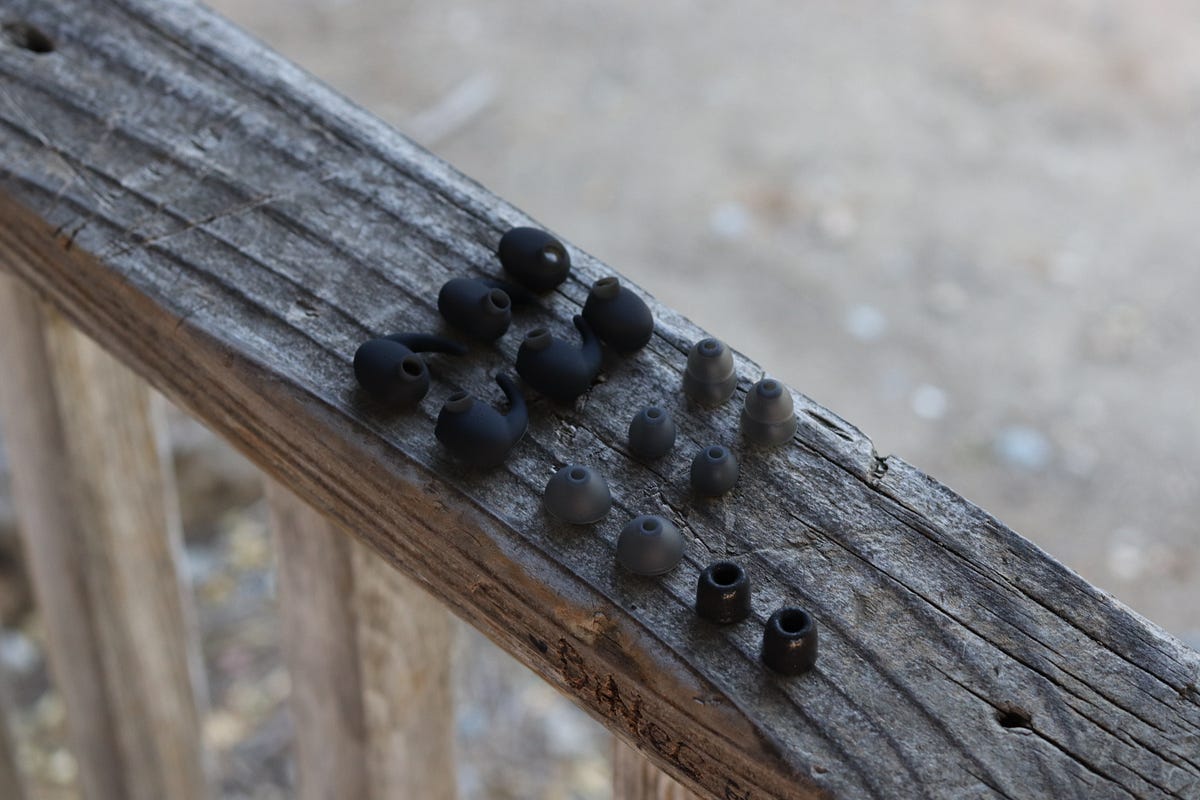
- 1x soft carrying case
- 4x sets of ear-hooks
- 4x sets of silicone eartips
- 1x set of foam eartips
Akoustyx takes great pride in the R1-series’ earhooks. According to their website, the R-1 series earhooks are licensed from a Norwegian company called Freebit. This “ear-interface” technology is well-proven and is used by tons of different companies. These ear-hooks play a key role in keeping the R-110 stable in the ear and make it a viable budget alternative to custom-molded IEMs for listeners who need a high level of security.
The soft carrying case that the R-110 comes with is highly functional. It is large enough to store the R-110 coiled in any way you’d like, so there’s no need to learn a new technique just to use it to keep your IEMs safe. The case features a little zipper compartment for storing some small objects. I use it to keep all my extra eartips and earhooks in one place. Further, it has padded edges and is made out of a shock-absorbent material that dissipates force from drops exceedingly well. So while you could probably toss your R-110 out the second story window in this and have it come out unscathed, I would be weary leaving it in a backpack containing multiple hard, heavy objects. This case’s specialty is not protecting from crushes, but drops.
Comparisons
1: Massdrop x Nuforce EDC3 ($99)
The EDC3 is a pretty “flat” IEM with some very subtle bumps in the treble and a roll-off into the bass. By comparison, the R-110 is a“V-shaped” IEM with a more emphasized upper midrange, more energetic treble, and slightly more emphasized bass. Let me stress that this is all in relative terms, as the R-110 isn’t exactly what you’d call an actual V-shaped IEM. At least not compared to the likes of the LZ A5 and DK-3001. In reality, the R-110’s bass is pretty linear with its lower-midrange.
2: Periodic Audio Mg ($99)
The Periodic Audio Mg is a warmer IEM than the R-110. It has a more “friendly and fun” take on music than the R-110, likely owing to its dynamic driver (a stark contrast to the R-110’s single balanced-armature driver). The Mg is more V-shaped than the R-110, recessing its midrange more and elevating its bass and upper-treble beyond that of the R-110. The Mg is less detail-oriented than the R-110, however. That is to be expected though, coming down mostly due to the differences between their two driver technologies and target sound signatures. The R-110 suites listeners who prefer analytic sound signatures, while the Mg will suit those who love warm and engaging sound signatures.
Summary
The R-110 is an excellent buy for those looking for entry into stage-monitor-styled earphones. It provides ergonomic stability and comfort along-side even and detailed music reproduction. Combine that with its reasonable pricing, good accessory package, and excellent isolation capabilities and you have a recipe for an excellent purchase value. So if you are an aspiring musician who wants a monitor for live performances, an audiophile who appreciates even and accurate sonic reproduction, or just a fan of IEMs that won’t ever fall out of your ears, the R-110 is worth your attention.
As always, happy listening!

